L'Escalade
L'Escalade, or Fête de l'Escalade (from escalade, the act of scaling defensive walls), is an annual festival in Geneva, Switzerland, held each December in celebration of the defeat of an attempt to conquer the Protestant city by the Catholic Duchy of Savoy. Troops sent by Charles Emmanuel I, Duke of Savoy, attempted a surprise attack during the night of 11–12 December 1602, but according to legend, were repulsed by a cook who dumped boiling vegetable soup on the invaders before raising an alarm. The celebrations and other commemorative activities are usually held on 12 December or the closest weekend.
| Fête de l'Escalade | |
|---|---|
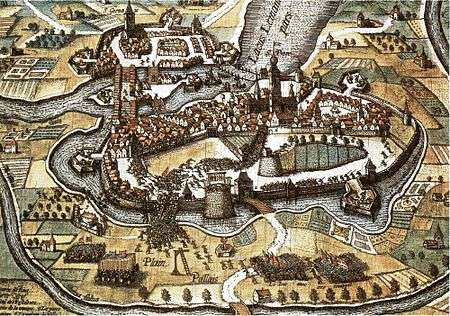 L'Escalade is what Genevans call the failed surprise attack of 12 December 1602 by troops sent by Charles Emmanuel I, Duke of Savoy, to take Geneva. This imaginative image was drawn by Matthias Quad, or the workshop of Franz Hogenberg, around 1603. Invaders are pictured crossing the moat in the center left while reinforcements are entering Plainpalais at the bottom. A column of defenders is in the center, headed toward the Savoyards. Lake Léman is at center top. | |
| Observed by | Geneva, Switzerland |
| 2019 date | 6 December to 8 December[1] |
| Frequency | annual |
Background
For years, the duke coveted the wealth of the self-governing, independent, republican, Protestant city-state. When Charles Emmanuel came to the throne of the House of Savoy in 1580, he longed to make Geneva his capital north of the Alps and crush Protestantism. Pope Clement VIII offered encouragement; in 1602 he appointed as Catholic bishop of Geneva Francis de Sales, an effective preacher who had recently been successful in re-Catholicizing the Chablais district of Savoy on the south side of Lake Geneva.
Attack

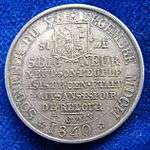
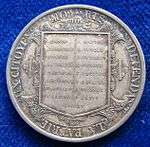
On December 11 and December 12 (Old Style) 1602—the darkest night of the year—the forces of the Duke of Savoy, under the command of the seigneur d'Albigny, and those of Charles Emmanuel's brother-in-law, Philip III of Spain, launched an attack on the city-state of Geneva.[2] The troops marched along the Arve River at night and assembled at Plainpalais, just outside the walls of Geneva, at 2 o'clock in the morning. The original plan was to send in a group of commandos to open the city gate and let the other troops in. The Geneva citizens defeated the invaders by preventing them from scaling the wall using cannon fire, and by fighting in the streets against the few who managed to climb over (a climb in French is an escalade). The alarm was raised, the church bells were rung and the Genevese were alerted. The night guard Isaac Mercier succeeded in cutting the rope holding up the portcullis, thus foiling the plan to open the main city gate. The populace fought alongside their town militia and the duke's 2000-plus mercenaries were defeated. The Genevese lost 18 men in the fighting; the Savoyards suffered 54 fatalities and the troops had to retreat. Thirteen invaders who had been taken prisoner, including several well-born gentlemen, were summarily hanged the following day as brigands, since they could not be treated as prisoners of war, peace having been repeatedly sworn on the part of Savoy.[3]
According to Genevese legend, Catherine Cheynel ("Mère Royaume"), originally from Lyon and the wife of Pierre Royaume, seized a large cauldron of hot soup and poured it on the attackers. The Royaume family lived just above the La Monnaie town gate. The heavy cauldron of boiling soup landed on the head of a Savoyard attacker, killing him. The commotion that this caused also helped to rouse the townsfolk to defend the city.[4]
After the defeat, the Duke of Savoy accepted a lasting peace, sealed by the Treaty of St. Julien of 12 July 1603.[5]
The story of L'Escalade is told in a song called "Cé qu'è l'ainô", written in a Franco-Provençal dialect around 1603 by an unknown author. The song has become the "national" anthem of Geneva; while the complete version comprises 68 stanzas, only four of them are usually sung.[6]
It was also celebrated in verse by Samuel Chappuzeau in his Genève Délivrée.[7]
Celebration
Although the armed conflict actually took place after midnight, in the early morning on December 12, celebrations and other commemorative activities are usually held on December 11 or the closest weekend. Celebrations include a large marmite (cauldron) made of chocolate and filled with marzipan vegetables and candies wrapped in the Geneva colours of red and gold. It is customary for the eldest and youngest in the room to smash the marmite, while reciting, "Ainsi périrent les ennemis de la République! " (Thus perished the enemies of the Republic), referring to how Catherine Cheynel, better known as Mère Royaume, poured boiling hot vegetable soup on soldiers climbing up the walls of the city. Other traditions include mulled wine, a large serving of soup, and children in various types of costumes knocking on people's doors and singing Escalade songs for candies. It is also common for children in school to prepare vegetable soup, which is served to parents and families that night. Teenagers tend to throw eggs, shaving cream, and flour at each other as part of the celebration. The high school students parade together by first going to "conquer" each other and end up in the central square of the old town after walking through the rues basses to the plaine de Plainpalais and back.[8]
There is also a parade on Friday evening: the names of the eighteen who died—Jacques Billon finally died of his wounds a year later—are called out, one after another. The historical procession on Sunday features more or less 800 people (from old Genevese families) with historical costumes, the remaining fragments of the ladders used by the Savoyards, and horses. This parade—organised since 1926 by the Compagnie de 1602—attracts every year generally tens of thousand spectators.[8]
Escalade Run
Since 1978 there has been another element to the celebration of the Escalade, with a road running event being held the weekend of or preceding the night of the 11th (depending on whether or not the 11th falls on a weekend). The run traditionally starts in the parc des Bastions and goes through the Old City of Geneva, before finishing near the start again. It is one of the most significant annual events in Geneva.[9] There are multiple events for different age groups.[10]
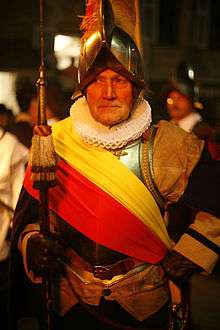 A soldier in the commemorative parade
A soldier in the commemorative parade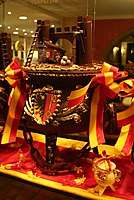 A chocolate "marmite de l'Escalade"
A chocolate "marmite de l'Escalade"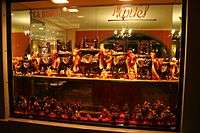 The window of a chocolate shop in Carouge selling marmites
The window of a chocolate shop in Carouge selling marmites
References
- Harby, Bill (2 December 2019). "Geneva's Escalade festival promises to repulse Savoyard attacks from 6 Dec 2019". Le News. Retrieved 6 December 2019.
- Gaspare Lorchano, Mercurius Gallobelgicus, vol. 4 (Cologne, Wilhelm Lutzenkirch, 1603), p. 465f. Available on Google Books
- Compagnie de 1602 Archived 2019-12-25 at the Wayback Machine.
- Denkinger, Henri; Guillot, Alexandre Henri; Goth, Charles (1902). L'escalade: trois récits (in French). Ch. Eggimann. pp. 96.
- "Histoire de l'Escalade" [History of the Escalade] (in French). City of Geneva. Retrieved 2019-12-06.
- Cé qu'è lainô: National hymn of Geneva Lyrics and French translation
- Chappuzeau, Samuel (1862) [1662]. Genève Délivrée (in French). Jules-Guillaume Fick – via Bibliothèque nationale de France.
- "L'Escalade". Geneva.info. Retrieved 6 December 2019.
- "Geneva celebrates historic defeat of Savoy enemy". swissinfo.ch. Swiss Broadcasting Company. 10 December 2010. Retrieved 6 December 2019.
- "A chacun sa course". Course de l'Escalade, Genève. Retrieved 6 December 2019.
Further reading
- Gaberel, Jean (1852). L'Escalade, son origine et ses conséquences [The Escalade, Its Origins and Consequences] (in French).
External links
| Wikimedia Commons has media related to L'Escalade. |
- Compagnie de 1602, the group who organises the yearly festival.
- La Course de l'Escalade.
- World History at KMLA: The Savoyard attack on Geneva.
- Fête de l'Escalade: a yearly celebration in Geneva in memory of the night attack by the Savoyards in 1602.